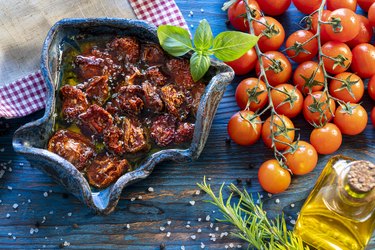
The effects of drying on food quality are both negative and positive. While dehydrated foods lose many of their nutrients, you don't have to worry about them going bad. Not to mention they make for great snacks.
Tip
While dehydrated fruits don't spoil, they do lose some of their nutrients in the drying process.
Video of the Day
Pros and Cons of Dehydrated Food
Let's begin with the benefits of dehydrated food. According to the University of Missouri, foods that are dehydrated will not spoil. Why? In order to grow, bacteria, yeast and mold need water — something that dehydrated foods lack.
Video of the Day
Their other benefits have mostly to do with their convenience. Campers and hikers will often pack dried foods for their light weight, and dried foods such as fruit leathers make for easy snacks. Moreover, dried vegetables are simple to store and can be added to some of your favorite recipes, from soups to stews.
Now, moving on to the negatives ... If you're wondering about the effect of drying on nutritional value of food, University of Missouri lays it out:
- Vitamins A and C are minimized due to heat and air.
- Sulfite treatment causes the destruction of thiamine.
- Blanching vegetables before drying destroys vitamin C, as well as B-complex vitamins, and induces the loss of some minerals. That said, blanching reduces vitamin A and C loss during the dehydration and storage stages.
- Dried food also tend to have more calories, as they have a greater nutrient concentration. For instance, 100 grams of fresh apricots contains 51 calories, while 100 grams of dried apricots contains 260 calories.
According to Better Health Channel, cooking dehydrated foods will only make them lose more nutrients. Further nutrients will be leached and dissolved in the cooking water.
Food Dehydration Steps
The Environmental Protection Agency (EPA) delineates the steps required to dehydrate food. You must begin with a pre-drying treatment, which will prepare the food for dehydration. Preparation includes:
- Selection and sorting
- Washing
- Peeling
- Cutting
- Blanching
- Color preservation
This last step in the predehydration treatment is also known as sulfuring, in which the food is treated with sulfur dioxide, an antioxidant and preservative. The presence of sulfur dioxide slows the browning of fruits and reduces the destruction of ascorbic acid and carotene.
The next step is drying the food, which you can do in one of three ways: oven drying, solar drying and electric dehydrator drying.
Once the food has been dried, EPA recommends treating the dehydrated product depending on its type. Treatments may involve sweating — when you contain the dehydrated product in bins or boxes to balance moisture content —, screening to remove dehydrated pieces of an undesired size, inspection, instantization to improve the rehydration rate and finally, packaging.
Food Dehydration Methods
When it comes to the actual drying of the fruit, there are three methods most commonly employed: solar drying, oven drying and using an electric dehydrator.
Solar drying is a method that requires, you guessed it: the sun. The sun's rays enter a unit, designed for this purpose, that's well-ventilated to remove moist air. The unit usually becomes 20 to 30 degrees Fahrenheit warmer than the outside air. The only downside to this method is that you cannot control the weather, and therefore may not receive your desired results if the conditions aren't right.
Oven drying and using an electric dehydrator are two indoor methods that require fairly little effort. Electric dehydrators are overall a better option as they require less energy and are less likely to burn foods at the end of the drying period. University of Missouri also suggests using a microwave oven if you're just dehydrating herbs.